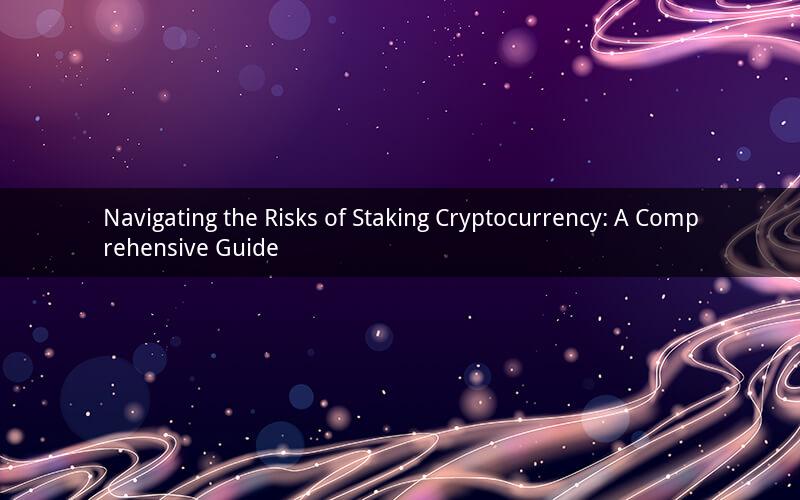
Staking cryptocurrency has emerged as a popular method for earning rewards in the digital asset space. However, like any investment, it comes with its own set of risks. In this article, we will delve into the potential risks associated with staking cryptocurrency, providing you with a comprehensive understanding of the factors to consider before participating in this activity.
1. Market Volatility
One of the most significant risks of staking cryptocurrency is market volatility. Cryptocurrency prices can fluctuate dramatically, leading to potential gains or losses. If the value of the cryptocurrency you are staking decreases significantly, you may experience a loss in the amount of staked coins, as well as the potential rewards you could have earned.
2. Lock-up Periods
Many staking platforms require users to lock up their cryptocurrency for a certain period, often referred to as a lock-up period. During this time, you will not be able to withdraw your staked coins or access the rewards earned. If the market takes a downturn, you may be unable to sell your staked coins to mitigate potential losses, which can be a significant risk factor.
3. Platform Security
Staking cryptocurrency involves entrusting your digital assets to a third-party platform. The security of these platforms is crucial, as any breach or hack could result in the loss of your staked coins. It is essential to research the reputation and security measures of the platform before participating in staking to minimize this risk.
4. Regulatory Changes
Cryptocurrency regulations are still evolving, and changes in laws and regulations can impact the staking process. Governments around the world are increasingly scrutinizing the digital asset space, which could lead to restrictions or outright bans on staking activities. Stakers must stay informed about regulatory developments and be prepared for potential changes in the legal landscape.
5. Centralization
Staking can sometimes lead to centralization, as large staking pools can accumulate significant influence over the network. This centralization can create a concentration of power, potentially leading to manipulation of the network's consensus mechanism. Stakers should be aware of the potential risks associated with centralization and consider the implications for the long-term sustainability of the cryptocurrency they are staking.
6. Inflation Risk
Some cryptocurrencies have a predetermined inflation rate, which can affect the value of your staked coins over time. As new coins are minted and distributed, the supply of the cryptocurrency increases, which can lead to a decrease in its value. Stakers should be aware of the inflation risk and consider the potential impact on their investment.
7. Technical Issues
Staking platforms may encounter technical issues, such as downtime or software bugs, which can disrupt the staking process. These issues can lead to missed rewards or, in some cases, the loss of your staked coins. It is crucial to choose a reputable platform with a strong track record of reliability and security.
8. Market Manipulation
The cryptocurrency market is susceptible to manipulation, and staking can be a target for malicious actors. Large staking pools may be used to manipulate prices, either to benefit the pool operators or to harm the cryptocurrency's value. Stakers should be vigilant and stay informed about potential market manipulation schemes.
9. Lack of Liquidity
Staking cryptocurrencies often requires a significant amount of capital, which can tie up your funds for an extended period. This lack of liquidity can be a risk, especially if you need to access your funds quickly. Stakers should consider their financial situation and ensure they have enough liquidity to cover their expenses during the lock-up period.
10. Reward Rate Changes
The reward rate for staking can change over time, depending on the cryptocurrency's algorithm and the network's demand. A decrease in the reward rate can impact the profitability of staking, and stakers should be prepared for potential changes in the reward structure.
In conclusion, staking cryptocurrency can be a lucrative investment opportunity, but it is essential to understand the associated risks. By being aware of market volatility, lock-up periods, platform security, regulatory changes, centralization, inflation risk, technical issues, market manipulation, lack of liquidity, and reward rate changes, you can make informed decisions and mitigate potential losses. Always conduct thorough research and consider seeking advice from financial professionals before participating in staking activities.
Questions and Answers:
1. What is the primary risk of staking cryptocurrency?
The primary risk of staking cryptocurrency is market volatility, which can lead to significant gains or losses in the value of your staked coins.
2. How can I minimize the risk of platform security when staking cryptocurrency?
To minimize the risk of platform security, research the reputation and security measures of the platform before participating in staking. Look for platforms with strong encryption, two-factor authentication, and a history of reliable performance.
3. What should I do if I encounter technical issues while staking cryptocurrency?
If you encounter technical issues while staking cryptocurrency, contact the platform's customer support team for assistance. They can help you resolve the issue and ensure your staked coins are safe.
4. How can I stay informed about regulatory changes affecting staking cryptocurrency?
To stay informed about regulatory changes, follow reputable news sources, government announcements, and cryptocurrency forums. This will help you stay up-to-date with the latest developments and adjust your staking strategy accordingly.
5. What is the difference between staking and mining?
Staking involves locking up your cryptocurrency to participate in the network's consensus mechanism and earn rewards, while mining involves using computational power to solve complex mathematical problems and validate transactions. Both methods require a significant investment of capital and come with their own set of risks and rewards.